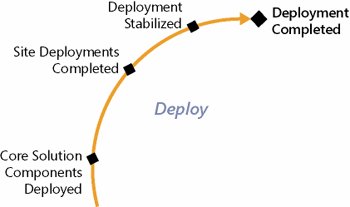Key Checkpoints
| The key checkpoints for the Deploy Track listed and described here: Major CheckpointThe major checkpoint concluding a Deploy Track is deployment completed. Deployment CompletedLead Advocacy Group: Release/Operations A deployment completed checkpoint concludes a solution delivery effort for this version or release of a solution (i.e., delivery of subsequent versions or releases might still be in the works). It signifies that all deployments have been completed, stabilized, and verified to be operationally stable. The appropriate operations and support systems, processes, and procedures are in place and functional. By this time, the deployed solution should be providing the expected business value to the customer(s). With this checkpoint ending solution delivery activities, all that potentially remains is project closure, which is discussed in the next chapter. Interim CheckpointsThe interim checkpoints for a Deploy Track are core solution components deployed, site deployments completed, and deployment stabilized, as depicted in Figure 11-1. Figure 11-1. Deploy Track checkpoints Core Solution Components DeployedLead Advocacy Group: Release/Operations Often, solutions are built around a core set of components that provide key services and are the nucleus or backbone for the entire solution. These are typically major components that are deployed to centralized operations centers. This checkpoint signifies that these core solution components have been deployed to their designated environments and have been verified to be operationally stable. These components do not typically represent an operational solution from a user's perspective. Instead, solution components that are considered core typically satisfy one or more of these criteria:
To avoid delays, core components can be reviewed, approved, and deployed in advance of other solution components that are still being stabilized. All of this should be detailed in a deployment plan with the proper acceptance checkpoints. Site Deployments CompletedLead Advocacy Group: Release/Operations Some solutions are deployed to distributed locations and, as such, involve site deployments. This checkpoint signifies that all site deployments have been completed, including being integrated with the core components and possibly with other sites. At this checkpoint, all users should have access to a solution. Because deployments are complete but not yet fully stabilized (that is the next checkpoint), it is expected that some issues will arise with the various site deployments. However, from an overall perspective, the whole solution should be operationally stable; enough for each site owner to sign off on the deployment. One measure of achieving site-owner satisfaction is site owners' willingness to sign off on their site deployment. Signing off provides validation of customer acceptance at the specific site. After achieving this checkpoint, the team makes a concentrated effort to resolve the remaining issues, finish deployment stabilization activities, and close out a project. Depending on a deployment plan, achieving this checkpoint is typically when the bulk of the remaining team starts to roll off a project. Only those needed to finish stabilization and project closure typically remain. It is essential that operations and support teams assume responsibility prior to this checkpoint. Because site deployments tend to be similar, it is a great learning opportunity for them to increase their readiness to a sufficient level. If they are not ready to assume responsibility by this checkpoint, it is highly likely operations acceptance of a solution will delay a project. Deployment StabilizedLead Advocacy Group: Release/Operations As with other stabilization efforts, this checkpoint signifies that all issues deemed necessary to resolve have been resolved and that the customer and team agree that solution operations, including the sites, satisfy predefined customer acceptance criteria. As an added indicator of stability, typically operational feedback is solicited from users and stakeholders. Based on this feedback, some final adjustments might be deemed important enough to address. |
EAN: 2147483647
Pages: 137
